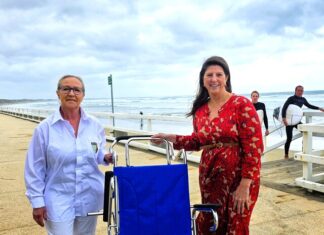Kim Waters
The disappearance of a Portarlington beach is evidence of environmental damage from dredging of Port Phillip Bay shipping channels, according to Australian Conservation Foundation.
The foundation has hit out at State Government plans to restore the beach with tonnes of quarried sand from another location, labelling it a “short-term solution to a long-term problem”.
Foundation marine campaign coordinator Chris Smythe said a controversial dredging project, which finished last year, had affected wave patterns and tides that in turn scoured away the beach.
The Government’s $8 million “enhancement program” would be an “inappropriate fix”, he said.
“If they come in and put tonnes of sand on the beaches without looking at the cause of the problem, all that sand will just wash away again,” Mr Smythe said.
“It may just be a waste of time and money.”
Mr Smythe said wave action determined the balance and size of sand on beaches, so dumping the wrong size or quality replacement would have “serious environmental impacts”.
Portarlington resident Colin Edwards said the channel deepening project had left the area’s beaches eroded “beyond recognition”.
“Most of the beaches are collapsing into the sea because of changed tidal influences and different wave patterns,” Mr Edwards said.
“We’ve got rougher waters coming in and out of the bay now and the waves aren’t the same as they used to be.”
Bellarine Foreshore Committee of Management chief executive officer Tim Page-Walker backed the Government’s plan.
“We have been the recipient of about $80,000 of funding for the Portarlington beach,” Mr Page-Walker said.
“So far we’re in the design stage and after that we’ll move into the actual building of the beach.”
Mr Page-Walker said “storms, high tides and even possibly the dreaded climate change” had impacted the coast.
He did not say whether he believed the channel deepening had an impact.
“Areas of our coast have eroded more in recent years than in the past,” he said.
Mr Page-Walker was aware of a damage “risk” to the beach if the project dumped the wrong sand.
He said the project would be unable to source enough sand “locally”.
“There’s always a risk if you’re going to import materials into a natural environment but part of the responsibility of this project is to look at the sand profile and try to match it.
“In the past we’ve always used local sand for any beach developments but we wouldn’t be able to get that much sand from a local source.”
Department of Sustainab-ility and Environment engagement and communications adviser Amy Dynes defended the project.
Ms Dynes said injecting large amounts of quarried sand onto beaches was an “effective option to protect the foreshore from its natural coastal erosion process caused by wind, waves and tides”.
Quarry sand was subject to rigorous testing to ensure it was suitable for the beach, she said.
Get the latest news to your email inbox FREE!
REGISTER





